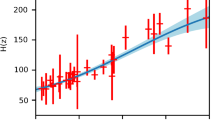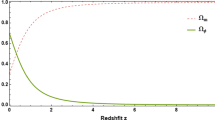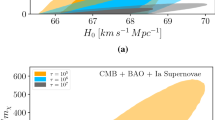Abstract
Using the exact Lemaitre–Bondi–Tolman solution with a non-vanishing cosmological constant Λ, we investigate how the presence of a local spherically symmetric inhomogeneity can affect apparent cosmological observables, such as the deceleration parameter or the effective equation of state of dark energy (DE), derived from the luminosity distance under the assumption that the real space-time is exactly homogeneous and isotropic. The presence of a local underdensity is found to produce apparent phantom behavior of DE, while a locally overdense region leads to apparent quintessence behavior. We consider relatively small large scale inhomogeneities which today are not linear and could be seeded by primordial curvature perturbations compatible with CMB bounds. Our study shows how observations in an inhomogeneous ΛCDM universe with initial conditions compatible with the inflationary beginning, if interpreted under the wrong assumption of homogeneity, can lead to the wrong conclusion about the presence of “fake” evolving dark energy instead of Λ.



Similar content being viewed by others
References
A.G. Riess et al. (Supernova Search Team Collaboration), Astron. J. 116, 1009 (1998). arXiv:astro-ph/9805201
J.L. Tonry et al. (Supernova Search Team Collaboration), Astrophys. J. 594, 1 (2003). arXiv:astro-ph/0305008
R.A. Knop et al. (The Supernova Cosmology Project Collaboration), Astrophys. J. 598, 102 (2003). arXiv:astro-ph/0309368
B.J. Barris et al., Astrophys. J. 602, 571 (2004). arXiv:astro-ph/0310843
A.G. Riess et al. (Supernova Search Team Collaboration), Astrophys. J. 607, 665 (2004). arXiv:astro-ph/0402512
S. Perlmutter et al. (Supernova Cosmology Project Collaboration), Astrophys. J. 517, 565 (1999). arXiv:astro-ph/9812133
C.L. Bennett et al., Astrophys. J. Suppl. 148, 1 (2003). arXiv:astro-ph/0302207
D.N. Spergel et al., arXiv:astro-ph/0603449
Y. Nambu, M. Tanimoto, arXiv:gr-qc/0507057
T. Kai, H. Kozaki, K.i. nakao, Y. Nambu, C.M. Yoo, Prog. Theor. Phys. 117, 229 (2007). arXiv:gr-qc/0605120
A.E. Romano, Phys. Rev. D 75, 043509 (2007). arXiv:astro-ph/0612002
D.J.H. Chung, A.E. Romano, Phys. Rev. D 74, 103507 (2006). arXiv:astro-ph/0608403
S. Alexander, T. Biswas, A. Notari, D. Vaid, arXiv:0712.0370 [astro-ph]
H. Alnes, M. Amarzguioui, O. Gron, Phys. Rev. D 73, 083519 (2006). arXiv:astro-ph/0512006
A.E. Romano, Phys. Rev. D 76, 103525 (2007). arXiv:astro-ph/0702229
A.E. Romano, arXiv:0911.2927 [astro-ph.CO]
A.E. Romano, arXiv:0912.2866 [astro-ph.CO]
M.N. Celerier, K. Bolejko, A. Krasinski, arXiv:0906.0905 [astro-ph.CO]
G. Lemaitre, Ann. Soc. Sci. Brux. Ser. I Sci. Math. Astron. Phys. A 53, 51 (1933)
R.C. Tolman, Proc. Natl. Acad. Sci. 20, 169 (1934)
H. Bondi, Mon. Not. R. Astron. Soc. 107, 410 (1947)
G.C. Omer, Proc. Natl. Acad. Sci. 53, 1 (1965)
A. Zecca, Nuovo Cimento B 106, 413 (1991)
J.E. Felten, R. Isaacman, Rev. Mod. Phys. 58, 689 (1986)
D. Edwards, Mon. Not. R. Astron. Soc. 159, 51 (1972)
A.E. Romano, M. Sasaki, arXiv:0905.3342 [astro-ph.CO]
M.N. Celerier, Astron. Astrophys. 353, 63 (2000). arXiv:astro-ph/9907206
C. Hellaby, PoS ISFTG, 005 (2009). arXiv:0910.0350 [gr-qc]
V. Sahni, A. Starobinsky, Int. J. Mod. Phys. D 15, 2105 (2006). astro-ph/0610026
V. Sahni, A. Shafieloo, A.A. Starobinsky, Phys. Rev. D 78, 103502 (2008). arXiv:0807.3548 [astro-ph]
V. Sahni, A. Shafieloo, A.A. Starobinsky, Phys. Rev. D 78, 103502 (2008). arXiv:0807.3548 [astro-ph]
C. Zunckel, C. Clarkson, Phys. Rev. Lett. 101, 181301 (2008). arXiv:0807.4304 [astro-ph]
A.A. Starobinsky, Phys. Lett. B 117, 175 (1982)
A.A. Starobinsky, JETP Lett. 42, 152 (1985)
M. Sasaki, E.D. Stewart, Prog. Theor. Phys. 95, 71 (1996). arXiv:astro-ph/9507001
N. Mustapha, C. Hellaby, Gen. Relativ. Gravit. 33, 455 (2001). astro-ph/0006083
D.H. Lyth, K.A. Malik, M. Sasaki, J. Cosmol. Astropart. Phys. 0505, 004 (2005). astro-ph/0411220
R.A. Sussman, Class. Quantum Gravity 27, 175001 (2010). arXiv:1005.0717 [gr-qc]
A. Shafieloo, V. Sahni, A.A. Starobinsky, Phys. Rev. D 80, 101301(R) (2009). arXiv:0903.5141 [astro-ph.CO]
Acknowledgements
AER is supported by MEXT Grant-in-Aid for the global COE program at Kyoto University, “The Next Generation of Physics, Spun from Universality and Emergence”. MS is supported in part by JSPS Grant-in-Aid for Scientific Research (A) No. 21244033, and by JSPS Grant-in-Aid for Creative Scientific Research No. 19GS0219. AS acknowledges RESCEU hospitality as a visiting professor. He was also partially supported by the grant RFBR 08-02-00923 and by the Scientific Programme “Astronomy” of the Russian Academy of Sciences.
Author information
Authors and Affiliations
Corresponding author
Appendix: Calculating the density contrast
Appendix: Calculating the density contrast
In the text, we have carried out all our calculations in the coordinates (η,r) since this allows one to take full advantage of the existence of an analytical solution. But if we are interested in the radial profile of a quantity on a fixed time-slice t=constant, we need to go back to the coordinates (t,r). Below we carry this out for the density contrast, δ=(ρ(t,r)−ρ(t,∞))/ρ(t,∞), where our LTB model is assumed to approach a flat FLRW universe as r→∞.
We need to introduce the inverse of the function defined in Eq. (14), i.e., we need to express η as a function of (t,r), η=v(t,r), from

such that
The value of v(t,r) can be evaluated numerically by solving for x the equation
The function η=v(t 0,r) thus obtained is plotted for the different models in Figs. 4 and 13. As can be seen, η=v(t 0,r) varies substantially in the region of inhomogeneity, while it levels off to a constant far from the inhomogeneity.
The energy density in the coordinates (t,r) is given by
But since the analytical solution is given in terms of η we have another expression:
Then the density contrast on the hypersurface t=t 0 is given by
where

The density contrast is plotted in Fig. 5 for type I± inhomogeneities and Fig. 14 for type II± inhomogeneities.
The same as Fig. 1 but for inhomogeneity of types II− and II+
The same as Fig. 2 but for inhomogeneity of types II− and II+
The same as Fig. 3 but for inhomogeneity of types II− and II+
The same as Fig. 4 but for inhomogeneity of types II− and II+
The same as Fig. 5 but for inhomogeneity of types II− and II+
The same as Fig. 6 but for inhomogeneity of types II− and II+
The same as Fig. 7 but for inhomogeneity of types II− and II+
The same as Fig. 8 but for inhomogeneity of types II− and II+
The same as Fig. 9 but for inhomogeneity of types II− and II+
Rights and permissions
About this article
Cite this article
Romano, A.E., Starobinsky, A.A. & Sasaki, M. Effects of inhomogeneities on apparent cosmological observables: “fake” evolving dark energy. Eur. Phys. J. C 72, 2242 (2012). https://doi.org/10.1140/epjc/s10052-012-2242-4
Received:
Revised:
Published:
DOI: https://doi.org/10.1140/epjc/s10052-012-2242-4




















